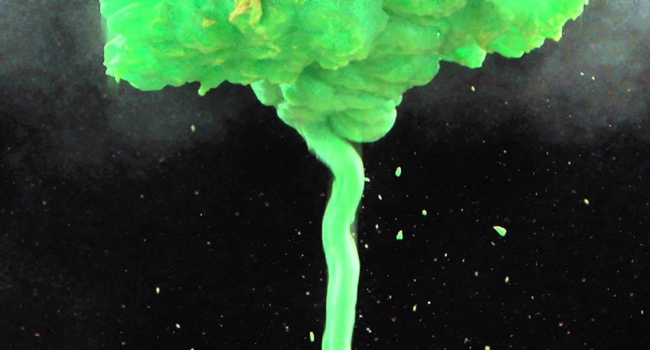 36. The Clash – The Clash (1977)
36. The Clash – The Clash (1977)
1977 is often considered the year punk rock was born. Although the Ramones had released their debut a year earlier, it was in ’77 when people began to take notice of this burgeoning movement. That same year saw The Clash release their debut album in the UK. It was packed full of punk anthems like “Janie Jones” and “White Riot,” but it also saw the band hinting at the ambition that we be further explored on its followups. The Clash always challenged convention, even in those early days, and more than 30 years later it still feels urgent. —David Anthony
 35. Portishead – Dummy (1994)
35. Portishead – Dummy (1994)
Three years prior to Dummy, trip hop’s distinct mix of hip-hop beats and arresting vocals catapulted from Bristol’s burgeoning scene via Massive Attack’s Blue Lines. Their debut was celebratory and often optimistic, whereas Portishead represented the flipside of the coin: doubt, gloom and surrender—sadness never sounded this beautiful or ethereal. Samples from old soundtracks are strewn across slow boiling beats that collude with Beth Gibbon’s achingly powerful voice to create a new, morphed soul sound. Production is also top notch, yielding to listeners the impression that Portishead is orchestrating each song within the intimacy of one’s (dimly-lit) bedroom. —Devin Costello
 34. U2 – Boy (1980)
34. U2 – Boy (1980)
When your guitar player’s name sounds like a heavyweight champion, people may confuse you for a thrash metal band. The only thing close to metal on Boy is The Edge’s cold guitar tone, as if someone melted a steel factory down to a single instrument. After the first ringing notes of “I Will Follow,” no one would mistake U2 for anything else. With the album art nothing but watery black and white faces, this is Bono, Edge, Adam Clayton and Larry Mullen, Jr. stripped down, hungry and even a little creepy (“An Cat Dubh”). Everyone’s grandmother knows this flag-waving band today; this is the sound of that flag being stitched together. —Alex Bahler
 33. Neutral Milk Hotel – On Avery Island (1995)
33. Neutral Milk Hotel – On Avery Island (1995)
It’s hard to not hear mention of Neutral Milk Hotel and immediately think of their sophomore record, In the Aeroplane Over the Sea, and while that album will likely continue to be their most celebrated release, On Avery Island also deserves a special place in each fan’s heart. Aeroplane may have mastered NMH’s sound but Avery Island is the album that introduced it. Singer Jeff Mangum’s endearing, straining vocals mixed with fuzz folk sensibilities masterfully backed by a collection of strings, horns and even a singing saw make this debut an emotional rollercoaster that shouldn’t be passed over. This isn’t Aeroplane: it might actually be something better. —Charlie Woodman
 32. Ramones – Ramones (1976)
32. Ramones – Ramones (1976)
At the height of pop music’s opulence and pomposity, when concert stages stood miles above the worshiping masses who lapped up month long guitar-solos, concept albums based on the philosophy of Hegel and retina-frying laser light shows, the Ramones’ self-titled debut saved the world. With 14 songs clocking in at less than 30 minutes, the four “bruddas” from Forest Hills, Queens hipped us to the long forgotten truth that rock ‘n’ roll was supposed to be loud, fast, stupid and most importantly, fun. Don’t let anyone tell you differently; this was the first punk rock record, before politics, nihilism, class warfare and anger fucked everything up again. —Brian Anderson
 31. Gang of Four – Entertainment! (1979)
31. Gang of Four – Entertainment! (1979)
Standing squarely at the intersection when Marxism meets punk rock is Entertainment!, the album that introduced Gang of Four to the world. Their suffusion of punk rock ethos with R&B whimsy is a formal wonder; their lyrical content left the realm of mere whininess and transcended the work of their peers. Who would have thought rumination Great Man theory could be so insatiably danceable? Only them, apparently. So many bands owe these guys a beer, it would take weeks to pay adequate dues. —Drew Hunt
 30. Violent Femmes – Violent Femmes (1983)
30. Violent Femmes – Violent Femmes (1983)
A band in 1983 that played mostly acoustic instruments like upright bass, xylophone and trash can drums was quite rare, and to do so with more passion than any of the current hardcore punk bands was shocking. The Violent Femmes debuted their self-titled album and their surf-rock, grass roots feel was spreading like wildfire. “Add it Up,” “Blister in the Sun” and “Gone Daddy Gone” wrote themselves into rock history. With a toe-tapping beat and Gordon Gano’s whiny, snarky vocals, the Violent Femmes prove to hold sway over the early ’80s and an alternative to run of the mill new wave and punk music. —Aaron Pylisnki
 29. LCD Soundsystem – LCD Soundsystem (2005)
29. LCD Soundsystem – LCD Soundsystem (2005)
LCD Soundsystem started with “Losing My Edge,” which was put together one evening while frontman and producer James Murphy began toying with his own recording equipment—though the single was executed with an attitude of a long time coming, and so was LCD Soundsystem. The debut featured infectious beats that made even the most aloof wallflowers swing their hips and nod their heads. Laced in these infectious disco-punk tracks was Murphy’s honest cynicism, seldom delivered deadpan in a way that captured Generation Y’s eerie amusement with irony. —Ciara Shook
 28. Yeah Yeah Yeahs – Fever to Tell (2003)
28. Yeah Yeah Yeahs – Fever to Tell (2003)
Fever to Tell is a rough and ready number punctured with primal screeches from Karen O and crunchy licks from guitarist Nick Zinner. Lyrics fit the tone with overt sexuality and noises from Ms. Karen that would sound right at home in her bedroom. The album’s biggest single, “Maps,” an innocent rock ‘n’ roll ballad fit for radio, is actually an odd duck compared to the rest of the album. “Y Control” is also more tame, but showcases how well the band members play off each other. Drummer Brian Chase’s creates a wonderful mix of percussive force that Zinner accentuates with groovy melodies. Karen O’s voice tops it off nicely by delivering her words with a soft touch. The ability of the three musicians and their natural chemistry are what make the album fantastic. It’s the reason why the Yeah Yeah Yeahs remain a great band, and why Fever to Tell is a dirty, sexy kick in the teeth. —Cody Prentiss
 27. Joy Division – Unknown Pleasures (1979)
27. Joy Division – Unknown Pleasures (1979)
The shadowy bleakness of Joy Divison’s Unknown Pleasures seemed a fitting soundtrack to the economic wreckage of the Mancunian industrial wasteland that the band was often photographed amidst. With equally portioned out elements of punk, industrial and goth rock, the songs are built around Peter Hook’s remorsefully melodic bass lines and Stephen Morris’ metronomic drumming, with Bernard Sumner’s jabbing and screeching guitar cutting savagely through the gloom. It is vocalist Ian Curtis, however, who demands our attention. His voice—part Bowie, more Morrison—moans and bellows with the anguish of one who sees the void that he is rushing helplessly towards. —Brian Anderson
 26. Wire – Pink Flag (1977)
26. Wire – Pink Flag (1977)
Before these post-punkers added the “post,” Wire knew how to kick out concise, sneering punk rock jams better than most of their peers. With tunes that clocked in at less than two minutes and which often veered into strange territory, Pink Flag remains a seminal ’77 record that cleared the way toward greater freedom of expression within punk’s typically strict guidelines. Listening to the diversity of these songs—whether it’s the steady guitar crunch of the post-punk foreshadowing “Strange,” the naked emotion of “Fragile” or the hardcore pulse of album closer “12XU”— it’s easy to understand Wire’s subsequent compulsive desire to reinvent itself. —Devin Costello
 25. Nas – Illmatic (1994)
25. Nas – Illmatic (1994)
Nasir Jones is a chubby-faced kid on the cover of Illmatic, but the album’s lyrics portrayed a man who had seen more than he should have, almost literally dying for a change. Capitalizing on the East’s resurgence in hip-hop, Nas did the practical thing for his debut: he made an album that sounded like rap’s birthplace (it opens with a rusty train thundering through a subway station). Dusty beats underscore hardened but passionate flow, wrapped in post-Bomb Squad minimalist intensity with all the comfort of a waterlogged Queens loading dock—everything at the intersection of 1994, rap and New York is in Illmatic‘s 10 tracks. —Alex Bahler
Intro | 60-49 | 48-37 | 36-25 | 24-13 | 12-1



